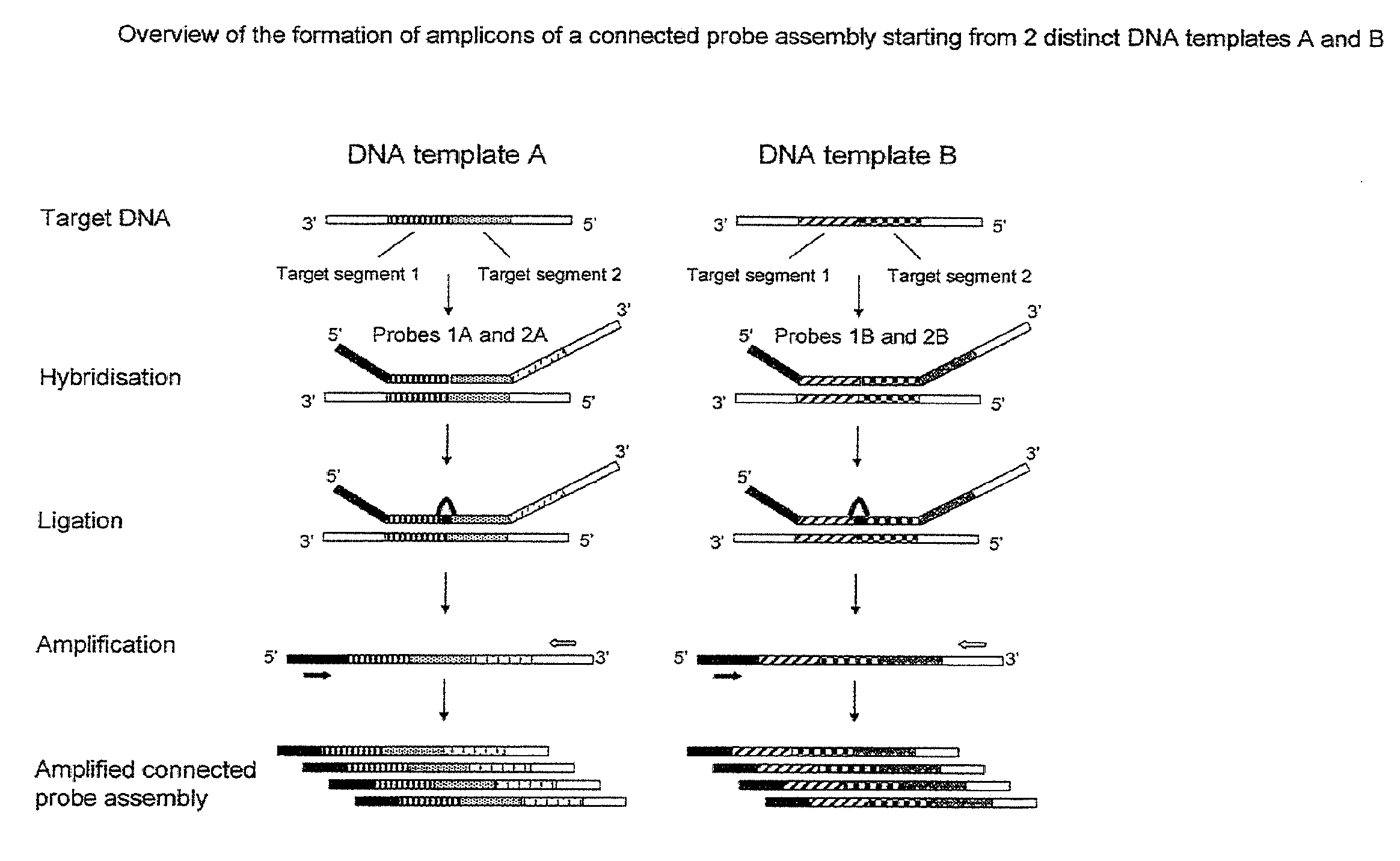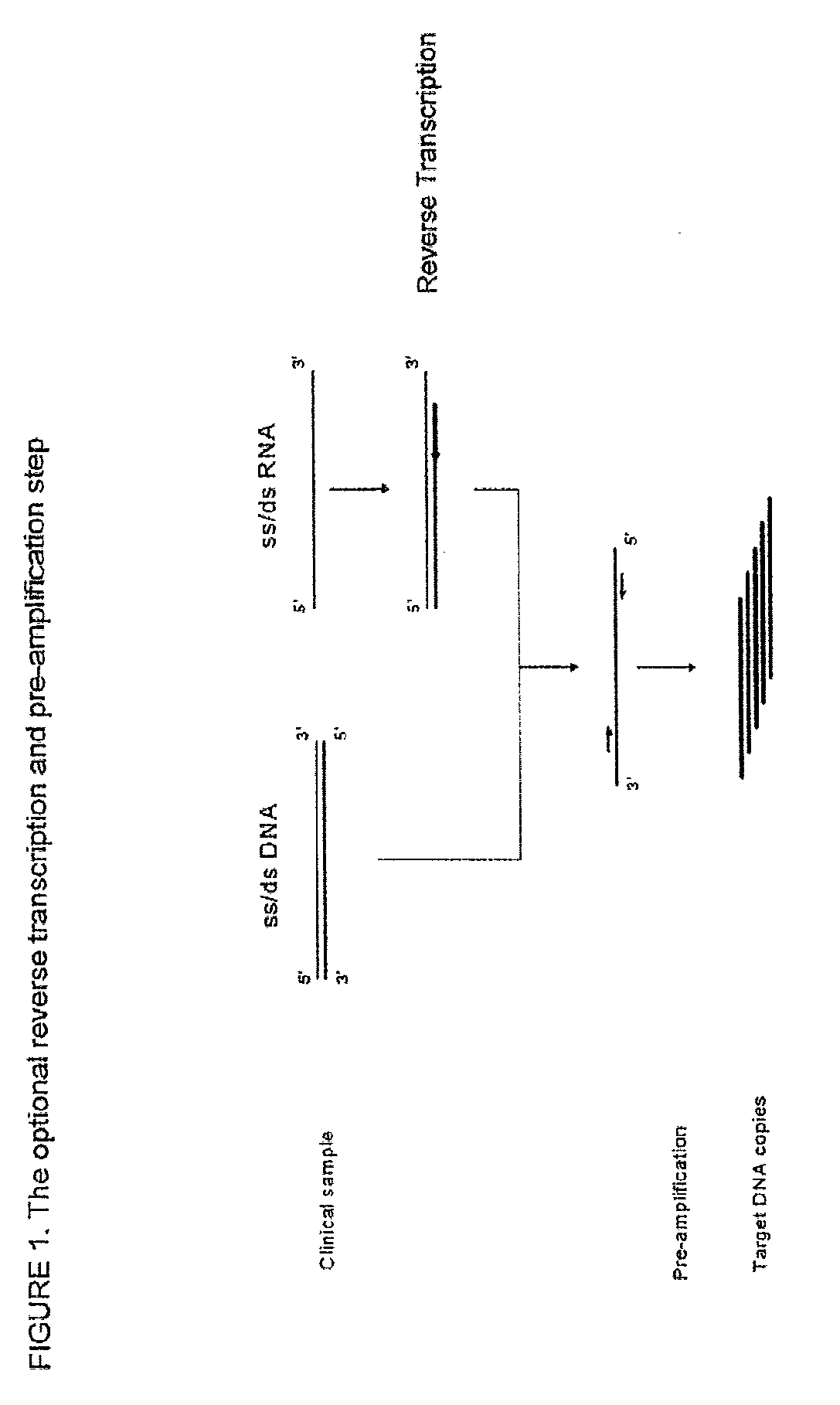Method for the simultaneous detection of multiple nucleic acid sequences in a sample
- Summary
- Abstract
- Description
- Claims
- Application Information
AI Technical Summary
Benefits of technology
Problems solved by technology
Method used
Image
Examples
example 1
Design of Probes and Primers
[0186]Viral and bacterial sequences were obtained from GenBank and Los Alamos database. Alignments (Clustal X v. 1.8.1) were performed on a set of sequences for each virus to identify highly conserved regions. Since some of the target pathogens are RNA viruses, a reverse transcriptase step followed by pre-amplification step was performed in order to obtain a plurality of different target DNA templates. Based upon these highly conserved regions, reverse transcriptase (RT)-PCR primers and ligation probes were designed. Table 1 lists the target regions, Gen Bank accession numbers and position for the sequences that serve as a template for the hybridisation of the first and second nucleic acid probes.
[0187]Conserved regions in the matrix protein gene (M1) were selected as the target for amplification and detection of influenza A virus. These primers are suitable for the amplification of a variety of strains, including, but not limited to, H3N2, H2N2, H4N2, H3...
example 2
[0199]A nasopharyngeal lavage was used as clinical specimen. The MagnaPure nucleic acid system (Roche Diagnostics, Almere, The Netherlands) was used as extraction method. The Total nucleic acid isolation kit and the Total nucleic acid lysis extraction MagnaPure protocol were applied. Extractions were performed according to the manufacturer's instructions. Briefly, 200 μl of starting material was used and the purified nucleic acid was eluted in a final volume of 100 μl. Before starting the extraction, 5 μl (approximately 150 copies) of an Internal Amplification Control (IAC) was added to the lysed sample.
example 3
Pre-Amplification
[0200]The extracted nucleic acid with IAC was placed in a separate reaction tube and the mix of primers as shown in table 2 was added along with reagents for reverse-transcription followed by pre-amplification (RT-PCR). While any procedure known in the art for RT-PCR may be used, the following procedure was used in this example. OneStep RT-PCR (Qiagen, Hilden, Germany) was performed in 25 μl containing 5 μl OneStep RT-PCR buffer (12.5 mM MgCl2; pH 8.7 (20° C.)), 1 μl deoxy nucleoside triphosphate (dNTP) mix (containing 1.6 μM of each dNTP), 2.5 μl primermix (containing 2 μM of each primer), 1 μl of OneStep RT-PCR Enzyme mix, 5.5 μl RNase free water and 10 μl of the extracted nucleic acid template with IAC. A blank reaction control was prepared by adding RNase free water to one reaction tube in place of nucleic acid template. The reaction tubes were placed in a Biometra T1 Thermocycler (Biometra, Goëttingen, Germany) programmed as follows: 30 minutes at 50° C. revers...
PUM
| Property | Measurement | Unit |
|---|---|---|
| Temperature | aaaaa | aaaaa |
| Molar density | aaaaa | aaaaa |
| Melting point | aaaaa | aaaaa |
Abstract
Description
Claims
Application Information
 Login to View More
Login to View More - R&D Engineer
- R&D Manager
- IP Professional
- Industry Leading Data Capabilities
- Powerful AI technology
- Patent DNA Extraction
Browse by: Latest US Patents, China's latest patents, Technical Efficacy Thesaurus, Application Domain, Technology Topic, Popular Technical Reports.
© 2024 PatSnap. All rights reserved.Legal|Privacy policy|Modern Slavery Act Transparency Statement|Sitemap|About US| Contact US: help@patsnap.com










